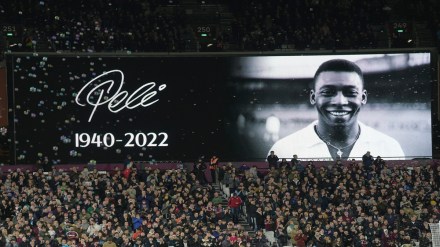By Tushar Bhaduri
Pele – the four letters in popular usage to describe anyone who fancies himself with a football. And one doesn’t have to be a fan of the legend and the sport to use it. Because the name transcends football, and sport in general. Any layman would know that Pele represents unparalleled excellence with the round ball. It’s a rare instance of a noun being used as an adjective as well.
That’s why the demise of Edson Arantes do Nascimento was felt so deeply even outside the sporting world. Pele’s name can be taken in the same breath as Muhammad Ali, Don Bradman and Roger Federer, synonymous with their sports for those outside their ambit.
Pele is the only footballer to win the FIFA World Cup three times as a player, scoring 12 goals in 14 matches. But that’s not the sole reason the ‘Black Pearl’, as the Brazilian was known throughout the world, captured everyone’s imagination.
He was the first footballer who broke the stranglehold of formations and tactics to show what a supremely talented individual could do. In short, Pele showed what was possible to do with a football.
It is poignant to think that Pele passed away just over 10 days after Lionel Messi, the modern player who is often compared with O Rei (The King) for the title of the Greatest of All Time, finally won the World Cup, on his fifth attempt. Fellow Argentine Diego Maradona may have his own legion, who claim that it’s he who is the Greatest, based largely on his otherworldly exploits during the 1986 World Cup, but Pele and Messi trump him on the basis of sustained excellence over a longer period of time.
Also read: Football legend Pele dies at 82, daughter says on Instagram
That all these legends, as also Neymar, hail from South America, tells its own tale. Europe has been the dominant continent in football, both in the international and club game over the last few decades, with almost all the top players in the world plying their trade in European leagues. Its success is largely based on a robust structure, tough competition and professional approach to the sport. The primacy of the team, and not the individual, is stressed upon at all times.
At the risk of stereotyping, grassroots football in South America is still a lot more like kids playing in narrow streets, learning to control and dribble the ball in tight spaces. That’s where all the individual flair originates. That quality is often superseded by the theoretical and strategic side of football, when the best of the Latin talent moves to Europe.
That Pele played for his beloved club Santos throughout his career (he signed up with New York Cosmos close to the end of his playing days, long after he had retired from international football) may explain why he was not Europeanised, in a footballing sense.
Also read: Green energy and just transition
Not that there were no offers for his considerable skills, the major European clubs came with cheque books in hand, but with Brazil legally naming Pele as ‘national treasure’, that virtually closed the door on him moving abroad. Santos’ tours around the world were meant to be a compromise of sorts, to showcase the phenom as a limited-edition offer.
As a result, the Brazilian team in those days was more about the Samba flair than the more structured system seen from the 1990s onwards.
It was a different world, in a footballing sense to the one where Messi could be moved on a permanent basis from his hometown of Rosario to Barcelona when he was not even in his teens. That may explain why he was identified more in the shirt of the Catalan giants than that of the Albiceleste for a major part of his career.
Man of moments
Coming back to Pele, what one remembers him by, including those who have seen him in action live or those who have read or seen footage of him, are the memories and moments, more than the goals.
It could be the incredible dummy he sold the goalkeeper by moving away from the ball in a one-on-one situation before missing an open goal, the audacious strike from the halfway line, the memorable save by England custodian Gordon Banks at the 1970 World Cup, or his assist in the fourth goal in the final of that tournament against Italy, considered one of the best team goals in the history of the tournament.
The unique charm of Pele could also be attributed to the fact that he virtually grew up in front of the world – from a 17-year-old at the 1958 World Cup in Sweden where he netted a hat-trick in the semifinal and a brace in the final, to the senior statesman in the dream team 12 years later.
Pele may be perceived as more of an ‘establishment man’, in both Brazil and FIFA matters, in complete contrast to Maradona, and may have had his fair share of detractors, there’s no denying the pure joy he gave to those who had the good fortune of watching him play.
With the likes of Pele, Maradona, Johan Cruyff, Bobby Moore, Paolo Rossi, Socrates and other such legends no longer among us, it’s one formidable team being gradually assembled up there, to play for posterity.
